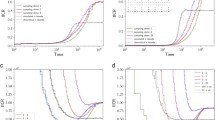Abstract
This work studies the coalescent (ancestral pedigree, genealogy) of the entire population. The coalescent structure (topology) is robust, but selection changes the rate of coalescence (the time between branching events). The change in the rate of coalescence is not uniform, rather the reduction in the time between branching events is greatest when the coalescent is small (immediately after the common ancestor is the only member of the coalescent) with little change when the coalescent is large (immediately preceding when that common ancestor becomes fixed and the size of the coalescent is N). This provides that the reduction in the coalescent time due to selection is much greater than the reduction in the cumulative size of the coalescent (total number of ancestors of the present population after and including the most recent common ancestor) due to selection. If Ns ≫ 1, the coalescent and fixation times are approximately equal to \( \tfrac{{\ln 2N s}} {s} \) , which is much less than the value N which would result from neutral drift (N rather than the canonical haploid neutral fixation time 2N is the appropriate comparison for the model considered here), in particular, it is 70% less for Ns=10 and 95% less for Ns=100. However, for those values of Ns, and N ranging between 103 and 106, the reduction in the cumulative size of the coalescent of the entire population compared to the neutral case ranges from 17% to 65% (depending on the values of N and s). The coalescent time for two individuals for Ns of 10 and 100 is reduced by approximately 70% and 94%, respectively, compared with the neutral case. Because heterozygosity is proportional to the coalescent time for two individuals and the number of segregating alleles is proportional to the cumulative size of the coalescent, selection reduces heterozygosity more than it reduces the number of segregating alleles.
Similar content being viewed by others
References
Barton, N., 2000. Genetic hitchhiking. Philos. Trans. Roy. Soc. Lond. B 355, 1553–562.
Barton, N., Etheridge, A., 2004. The effect of selection on genealogies. Genetics 166, 1115–131.
Campbell, R., 1999. The coalescent time in the presence of background fertility selection. Theor. Popul. Biol. 55, 260–69.
Campbell, R., 2003. A logistic branching process for population genetics. J. Theor. Biol. 225, 195–03.
Chakraborty, R., Fuerst, P., Nei, M., 1980. Statistical studies on protein polymorphism in natural populations. III. Distribution of allele frequencies and the number of alleles per locus. Genetics 94, 1039–063.
Donnelly, P., Tavaré, S., 1995. Coalescents and genealogical structure under neutrality. Annu. Rev. Genet. 29, 401–21.
Durrett, R., 2002. Probability Models for DNA Sequence Evolution. Springer, New York.
Durrett, R., Schweinsberg, J., 2004. Approximating selective sweeps. Theor. Popul. Biol. 66, 129–38.
Dykhuizen, D., 1990. Experimental studies of natural selection in bacteria. Annu. Rev. Ecol. Syst. 21, 373–98.
Ewens, W., 1979. Mathematical Population Genetics. Biomathematics, vol. 9. Springer, New York.
Griffiths, R., Tavaré, S., 1994. Sampling theory for neutral alleles in a varying environment. Philos. Trans. Roy. Soc. Lond. B 344, 403–10.
Griffiths, R., Tavaré, S., 1997. Computational methods for the coalescent. In: Donnelly, P., Tavaré, S. (Eds.), Progress in Population Genetics and Human Evolution, IMA Volumes in Mathematics and its Applications, vol. 87, pp. 165–82. Springer, New York.
Holte, J., 1974. Extinction probability for a critical general branching process. Stoch. Proc. Appl. 2, 303–09.
Kaj, I., Krone, S., 2003. The coalescent process in a population with stochastically varying size. J. Appl. Probab. 40, 33–8.
Kaplan, N., Darden, T., Hudson, R., 1988. The coalescent process in models with selection. Genetics 120, 819–29.
Karlin, S., Taylor, H., 1975. A First Course in Stochastic Processes, 2 edn. Academic, New York.
Kimura, M., Ohta, T., 1969. The average number of generations until fixation of a mutant gene in a finite population. Genetics 61, 763–71.
Kingman, J., 1982a. The coalescent. Stoch. Proc. Appl. 13, 235–48.
Kingman, J., 1982b. On the genealogy of large populations. J. Appl. Probab. 19A, 27–3.
Krone, S., Neuhauser, C., 1997. Ancestral processes with selection. Theor. Popul. Biol. 51, 210–37.
Maynard Smith, J., 1971. What use is sex? J. Theor. Biol. 30, 319–35.
Neuhauser, C., Krone, S., 1997. The genealogy of samples in models with selection. Genetics 145, 519–34.
O’Connell, N., 1993. Yule process approximation for the skeleton of a branching process. J. Appl. Probab. 30, 725–29.
Polanski, A., Bobrowski, A., Kimmel, M., 2003. A note on distributions of times to coalescence, under time-dependent population size. Theor. Popul. Biol. 63, 33–0.
Przeworski, M. 2003. Estimating the time since the fixation of a beneficial allele. Genetics 164, 1667–676.
Sano, A., Shimizu, A., Iizuka, M., 2004. Coalescent process with fluctuating population size and its effective size. Theor. Popul. Biol. 65, 39–8.
Slatkin, M., 1996. Gene genealogies within mutant allelic classes. Genetics 143, 579–87.
Slatkin, M., Hudson, R., 1991. Pairwise comparisons of mitochondrial DNA sequences in stable and exponentially growing populations. Genetics 129, 555–62.
Stephan, W., Thomas Wiehe, T., Lenz, M., 1992. The effect of strongly selected substitutions on neutral polymorphism: Analytical results based on diffusion theory. Theor. Popul. Biol. 41, 237–54.
Tajima, F., 1990. Relationship between DNA polymorphism and fixation time. Genetics 125, 447–54.
van Herwaarden, O., van der Wal, H., 2002. Extinction time and age of an allele in a large finite population. Theor. Popul. Biol. 61, 311–18.
Author information
Authors and Affiliations
Corresponding author
Rights and permissions
About this article
Cite this article
Campbell, R.B. Coalescent Size Versus Coalescent Time with Strong Selection. Bull. Math. Biol. 69, 2249–2259 (2007). https://doi.org/10.1007/s11538-007-9218-9
Received:
Accepted:
Published:
Issue Date:
DOI: https://doi.org/10.1007/s11538-007-9218-9




